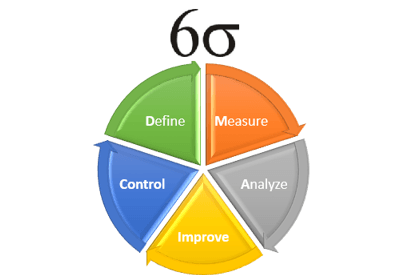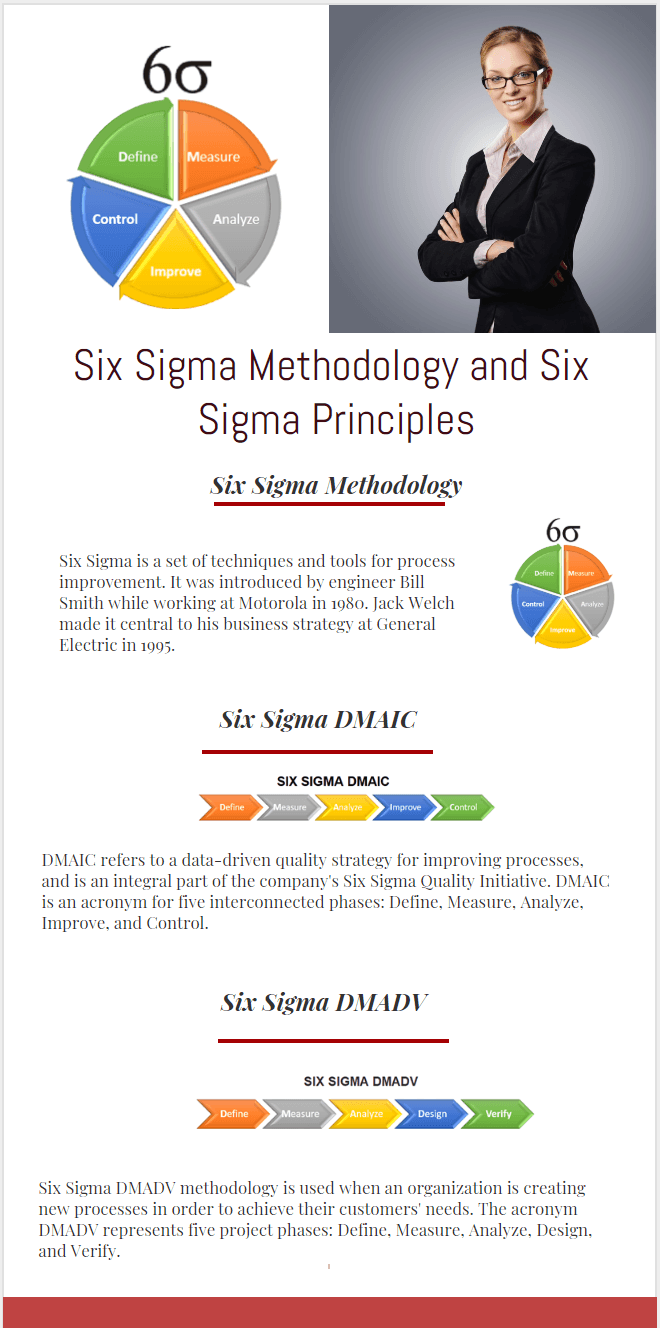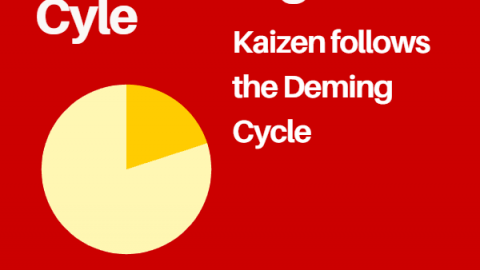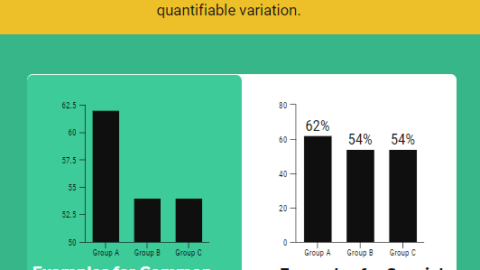A Dive into Six Sigma Methodology and Core Principles
Six Sigma is a powerful problem solving and process improvement tool which is developed by a quality assurance engineer Bill Smith at Motorola in 1986. Then it was registered in 1993 as a trademark of Motorola. The CEO of General Electric (GE), Jack Welch used this efficient technique for his business strategy in 1995. The Six Sigma Methodology involves a set of techniques to improve the quality of a process or a product by removing or minimizing the causes of defects. Professionals and organizations from all around the world use six sigma principles for improved business processes. Basically, the Six Sigma Methodology combines statistical methods with quality management methods to build a framework for process improvement within the organization. This article reviews the key aspects of Six Sigma DMAIC and DMADV Methodologies.
Table of Contents
Six Sigma Explained

The Six Sigma methodology aims to improve the quality of the process by analyzing and reducing defects and errors. It is a quality management process that is applicable to all industries such as manufacturing, finance, construction, healthcare, etc.
Six Sigma implementations and projects aim to reach specific targets such as reducing direct costs and indirect costs within the organization, decreasing water contamination, reducing project payback period and increasing stakeholder satisfaction. Each Implementation project has specifically defined steps, frameworks, and targets.
Apart from the other quality improvement techniques, Six Sigma aims to achieve measurable quantifiable and measurable results. Other techniques often rely on assumptions and estimates.
There are two basic methodologies for conducting a “Six Sigma” process which are DMAIC and DMADV.
Each term’s name is derived from the capital letters of the major steps in its process. The Deming Cycle (Plan-Do-Check-Act) inspires both DMAIC and DMADV methodologies.
The main difference between the two methodologies is DMAIC is used to improve the existing process while DMADV is used for new products or process. Both methodologies have five basic phases which are explained below.
Six Sigma Methodology DMAIC
The Six Sigma DMAIC method is used for correcting and improving an existing process.
1. Define: Identify customer requirements and project objectives.
2. Measure: Realise the current project performance and measure the various aspects of it by collecting inputs.
3. Analyze: Analyze the data and determine the root causes of any defects.
4. Improve: Optimize the current process and establish ways to improve the process.
5. Control: Create and implement control systems to control the future performance of the process. It is a continuous process aims to reach the desired quality level.
Six Sigma Methodology DMADV
The Six Sigma DMADV method is used for creating a new business process or product.
1. Define: Identify customer requirements and project goals.
2. Measure: Measure product capabilities, risks, and critical components.
3. Analyze: To develop and design alternatives
4. Design: Design the alternative which is the best-suited one in the Analyze step.
5. Verify: Verify the design by the help of simulations and implement the production process. Then hand over the process to the client or the process owner.
There are also various management tools used within the “Six Sigma” technique such as Five Whys, CTQ Tree, Root Cause Analysis, Scatter Diagram, Pareto Chart, etc.
Six Sigma Methodology Implementation Levels
Six Sigma implementation necessitates specially trained staff and certified professionals. Green Belt, Black Belt, and Master Black Belt are the three levels of Six Sigma Certification.
There are also white and yellow belt roles but their task is to assist higher level belts. Mostly they work part-time to help to improve the Six Sigma implementation by collecting data and other duties given by high-level belts.
- Green Belts: First certification level is the green belt. They mostly have a general understanding and knowledge on Six Sigma Principles. They participate in Six Sigma projects as a part-time employee.
- Black Belts: Black Belts are full-time experts working under the guidance of Black Master Belts. They are experienced team leaders.
- Master Black Belts: They guide employees for Six Sigma Implementation. They work with upper management in close cooperation.
Benefits of Six Sigma Methodology
Projects mostly suffer from poor quality customer dissatisfaction. Six Sigma is an efficient problem-solving technique that seeks to increase customer satisfaction. It aims to produce defect-free products (Six Sigma limits the defects per million opportunities less than 3.4).
Using the Six Sigma Methodologies and implementing its core principles provides many benefits to the organizations. Here below are some benefits of using this technique to improve the business processes.
Six Sigma helps to;
- Increase productivity
- Minimize defects
- Increase customer satisfaction
- Improve customer loyalty
- Improve the quality
- Improve employee satisfaction
- Reduce the cycle times
- Solve the problems effectively
- Determine the root cause of a problem
- Improve decision making
- Improves the business processes
- Reduce the operating costs
- Improve strategic planning
- Improve time management
- Create a vision for the company
- Ensure continuous improvement
Summary
Six Sigma is a popular process improvement methodology in business that focuses on customer satisfaction. The two methodologies DMAIC and DMADV are the sub methodologies of Six Sigma. Using this technique enables to reduce the number of defective products manufactured or services provided, resulting in increased revenue and greater customer satisfaction.
Lean Six Sigma is another concept which combines lean manufacturing and Six Sigma Principles. The Lean Six Sigma aims to remove wastes and provide an excellent process flow. Most of the large companies from various industries use Lean Six Sigma principles to improve operational efficiency. For more, you can read this article: What is Lean Six Sigma ?
External References
[1] American Society for Quality

Over 20 years in portfolio management, streamlining business processes, and systems integration. Utilizing best practices: PMI, Scrum, Agile, Kanban, Lean/Six Sigma, CMMI, ITIL and MOF. Extensive experience in managing in cross functional environment, getting to the root of the problem, bringing stakeholders together to resolve them. Vice President at Force3M Training.












